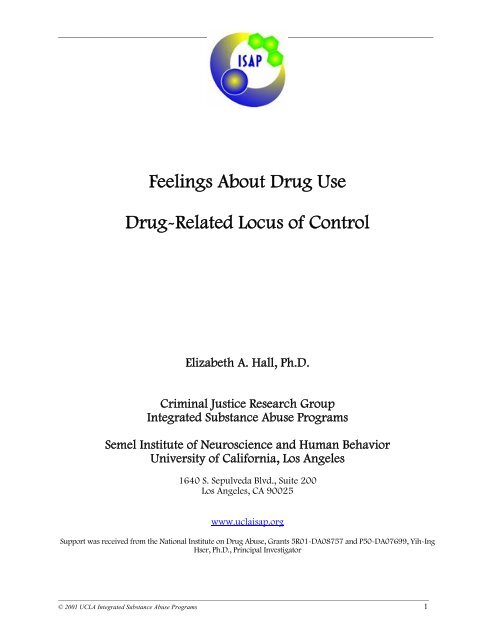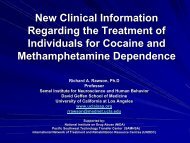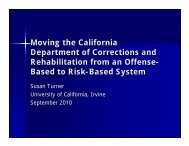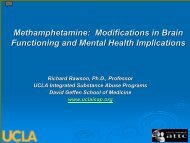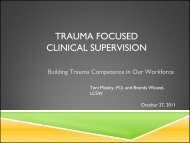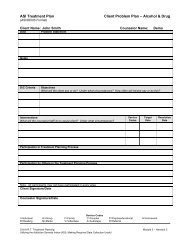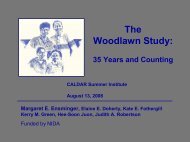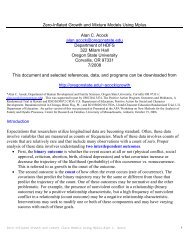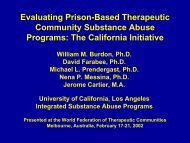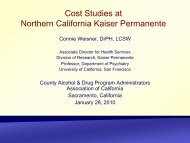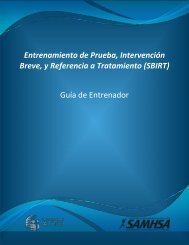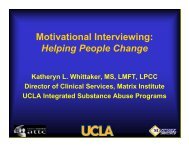FEELINGS ABOUT DRUG USE Drug-Related Locus of Control
FEELINGS ABOUT DRUG USE Drug-Related Locus of Control
FEELINGS ABOUT DRUG USE Drug-Related Locus of Control
You also want an ePaper? Increase the reach of your titles
YUMPU automatically turns print PDFs into web optimized ePapers that Google loves.
____________________________________________________________________________________________<br />
Feelings About <strong>Drug</strong> Use<br />
<strong>Drug</strong>-<strong>Related</strong> <strong>Locus</strong> <strong>of</strong> <strong>Control</strong><br />
Elizabeth A. Hall, Ph.D.<br />
Criminal Justice Research Group<br />
Integrated Substance Abuse Programs<br />
Semel Institute <strong>of</strong> Neuroscience and Human Behavior<br />
University <strong>of</strong> California, Los Angeles<br />
1640 S. Sepulveda Blvd., Suite 200<br />
Los Angeles, CA 90025<br />
www.uclaisap.org<br />
Support was received from the National Institute on <strong>Drug</strong> Abuse, Grants 5R01-DA08757 and P50-DA07699, Yih-Ing<br />
Hser, Ph.D., Principal Investigator<br />
__________________________________________________________________________________________________________________<br />
© 2001 UCLA Integrated Substance Abuse Programs 1
____________________________________________________________________________________________<br />
Feelings About <strong>Drug</strong> Use<br />
<strong>Drug</strong>-<strong>Related</strong> <strong>Locus</strong> <strong>of</strong> <strong>Control</strong><br />
Introduction ...................................................................................................................................................................2<br />
<strong>Locus</strong> <strong>of</strong> <strong>Control</strong> Theory ...............................................................................................................................................3<br />
<strong>Locus</strong> <strong>of</strong> <strong>Control</strong> Instrumentation..................................................................................................................................3<br />
LOC, Substance Abuse, and Treatment.........................................................................................................................4<br />
Developing the <strong>Drug</strong>-<strong>Related</strong> <strong>Locus</strong> <strong>of</strong> <strong>Control</strong> (DRLOC) Scale.................................................................................6<br />
Method...........................................................................................................................................................................6<br />
Setting........................................................................................................................................................................6<br />
Subjects .....................................................................................................................................................................7<br />
Client Measures .........................................................................................................................................................8<br />
Procedures .................................................................................................................................................................9<br />
Results .........................................................................................................................................................................10<br />
Reliability ................................................................................................................................................................10<br />
Scores by Demographic Group................................................................................................................................10<br />
Validity....................................................................................................................................................................10<br />
Program Modality....................................................................................................................................................11<br />
Discussion ...................................................................................................................................................................11<br />
References ...................................................................................................................................................................13<br />
INSTRUMENT: <strong>FEELINGS</strong> <strong>ABOUT</strong> <strong>DRUG</strong> <strong>USE</strong> <strong>Drug</strong>-<strong>Related</strong> <strong>Locus</strong> <strong>of</strong> <strong>Control</strong> (DRLOC)........................21<br />
SCORING: <strong>FEELINGS</strong> <strong>ABOUT</strong> <strong>DRUG</strong> <strong>USE</strong> <strong>Drug</strong>-<strong>Related</strong> <strong>Locus</strong> <strong>of</strong> <strong>Control</strong> (DRLOC) ...............................22<br />
Introduction<br />
<strong>Locus</strong> <strong>of</strong> control is one <strong>of</strong> the most extensively investigated constructs in psychological and<br />
social science literature (Carton & Nowicki, 1994; Rotter, 1990) and <strong>of</strong> potential use for substance<br />
abuse researchers and treatment practitioners. The <strong>Drug</strong>-<strong>Related</strong> <strong>Locus</strong> <strong>of</strong> <strong>Control</strong> scale is a 15-item,<br />
forced-choice measure <strong>of</strong> drug-use control expectancies in a variety <strong>of</strong> drug-use-related situations.<br />
__________________________________________________________________________________________________________________<br />
© 2001 UCLA Integrated Substance Abuse Programs 2
____________________________________________________________________________________________<br />
<strong>Locus</strong> <strong>of</strong> <strong>Control</strong> Theory<br />
<strong>Locus</strong> <strong>of</strong> control refers to internal states that explain why people actively deal with difficult<br />
circumstances. It concerns the beliefs that individuals hold regarding the relationships between<br />
action and outcome (Rotter, 1990; Lefcourt, 1991). <strong>Locus</strong> <strong>of</strong> control originated with Rotter’s social<br />
learning theory (Rotter, 1966). He defines internal versus external control as “the degree to which<br />
persons expect that a reinforcement or an outcome <strong>of</strong> their behavior is contingent on their own<br />
behavior or personal characteristics versus the degree to which persons expect that reinforcement is<br />
a function <strong>of</strong> chance, luck or fate, is under the control <strong>of</strong> powerful others, or is simply unpredictable”<br />
(1990, p. 489). Thus, for some individuals, outcomes are experienced as being dependent on the<br />
effort expended in their pursuit (internal control). Others experience outcomes as being the result <strong>of</strong><br />
external or impersonal forces such as luck, prayer, fate, or powerful others (external control)<br />
(Lefcourt, 1991).<br />
Researchers have found that an internal locus <strong>of</strong> control is associated with a more active<br />
pursuit <strong>of</strong> goals, such as social action, more spontaneous engagement in achievement activities,<br />
better interpersonal relationships, better emotional adjustment, a sense <strong>of</strong> well-being, and higher<br />
levels <strong>of</strong> performance, information seeking, alertness, and autonomous decision making. A more<br />
external locus <strong>of</strong> control is associated with depression, anxiety, and a lesser ability to cope with<br />
stressful life experiences (Carton & Nowicki, 1994; Crandall & Crandall, 1983; Lefcourt, 1991).<br />
<strong>Locus</strong> <strong>of</strong> <strong>Control</strong> Instrumentation<br />
The first commonly used LOC scale was developed by Rotter in 1966. Called the Internal-<br />
External <strong>Locus</strong> <strong>of</strong> <strong>Control</strong> Scale (I-E), both it (Rotter, 1966), and the later Adult Nowicki-Strickland<br />
Internal-External <strong>Control</strong> Scale (Nowicki & Duke, 1974, 1983), have been widely used and measure<br />
__________________________________________________________________________________________________________________<br />
© 2001 UCLA Integrated Substance Abuse Programs 3
____________________________________________________________________________________________<br />
generalized locus <strong>of</strong> control. However, one consistent criticism <strong>of</strong> the instrumentation <strong>of</strong> early LOC<br />
research is that LOC was treated as a unidimensional construct (Rotter, 1975; Lefcourt, 1982, 1991).<br />
As a result <strong>of</strong> this criticism, researchers have taken two approaches: (1) create multidimensional<br />
instruments, for example the Internality, Powerful Others, and Chance Scales (Levenson,1981) and<br />
the Multidimensional Health <strong>Locus</strong> <strong>of</strong> <strong>Control</strong> Scale (Wallston & Wallston, 1981); and (2) create<br />
instruments targeted toward specific aspects <strong>of</strong> control, such as, the Marital <strong>Locus</strong> <strong>of</strong> <strong>Control</strong> Scale<br />
(Miller et al., 1983) and the Mental Health <strong>Locus</strong> <strong>of</strong> <strong>Control</strong> Scale (Hill & Bale, 1980). According<br />
to Lefcourt (1991), maximal predictions are best obtained if the researcher tailors his or her<br />
measures to particular populations and their concerns rather than relying on more global and less<br />
targeted measures. This is supported by Abbott’s (1984) findings that Keyson and Janda’s (1972;<br />
Donovan & O’Leary, 1978) Drinking <strong>Related</strong> Internal-External <strong>Locus</strong> <strong>of</strong> <strong>Control</strong> scale (DRIE) was<br />
more predictive <strong>of</strong> treatment outcome for alcoholics than Rotter’s more generalized I-E scale. We<br />
chose to follow this approach by developing an instrument targeted toward a specific dimension <strong>of</strong><br />
control, drug abuse.<br />
LOC, Substance Abuse, and Treatment<br />
<strong>Drug</strong> abuse <strong>of</strong>ten develops into a chronic, relapsing condition that is resistant to treatment<br />
(Anglin, 1988; Gerstein & Harwood, 1990; Hser, Anglin, & Powers, 1993; Maddux & Desmond,<br />
1981; Simpson & Sells, 1990; Vaillant, 1988). Treatment success and relapse among drug abusers<br />
have been studied extensively (Brewer, et al., 1998; Hubbard, Craddock, Flynn, Anderson &<br />
Etheridge, 1997; Fletcher, Tims & Brown, 1997; Prendergast, Podus, & Chang, 1998; Simpson,<br />
Savage, & Lloyd, 1979). Some clear predictors <strong>of</strong> relapse have emerged, however, most are gross<br />
measures <strong>of</strong> a client’s demographic status, psychiatric status, or program attendance. For instance, a<br />
__________________________________________________________________________________________________________________<br />
© 2001 UCLA Integrated Substance Abuse Programs 4
____________________________________________________________________________________________<br />
recent meta-analysis <strong>of</strong> treatment for opiate addicts shows that unemployment, high levels <strong>of</strong> use, no<br />
prior abstinence, depression, association with drug-using peers, short treatment duration, and leaving<br />
treatment prior to completion are predictive <strong>of</strong> relapse (Brewer, et al., 1998). Longer treatment<br />
participation and participation in aftercare has been shown to improve relapse rates (Hubbard, et al.,<br />
1997; Miller, et al, 1997). <strong>Drug</strong>-related locus <strong>of</strong> control has the potential to be a more serviceable<br />
predictor to the field because it goes beyond general labels and is possibly modifiable through<br />
treatment (Abbott, 1984).<br />
Although locus <strong>of</strong> control is one <strong>of</strong> the most extensively investigated constructs in<br />
psychological and social science literature (Carton & Nowicki, 1994; Rotter, 1990), its use by<br />
substance abuse researchers has been limited. Most <strong>of</strong> the substance abuse research on LOC that<br />
does exist is hampered by sample sizes <strong>of</strong> under 100 and <strong>of</strong>ten under 50 (Canton, et al., 1988;<br />
Cohen, et al., 1982; Figurelli, et al., 1994; Hunter, 1994; Johnson, et al., 1991; Jones, 1985; Nurco,<br />
et al., 1995; Obitz & Oziel, 1978; O’Leary, et al., 1976; Oswald, et al., 1992; Walker, et al., 1980;<br />
and Weidman, 1983). The larger studies show: a significant correlation between internal locus <strong>of</strong><br />
control and greater personal treatment motivation (Murphy & Bentall, 1992); no relationship<br />
between 12-step spiritual beliefs and an external locus <strong>of</strong> control over drug use (Christo & Franey,<br />
1995); a significant correlation between a more internal locus <strong>of</strong> control and abstinence during the<br />
study period (Sadava, 1986); significant shifts toward an internal locus <strong>of</strong> control during treatment<br />
(Abbott, 1984; Walker, et al., 1979); significant differences in six-month outcomes clearly favoring<br />
those with internal DRIE scores (Koski-Jannes, 1994); and that among children <strong>of</strong> alcoholics,<br />
external orientation was significantly and positively correlated with having a parent who drank<br />
heavily and scores on the Beck Depression Inventory and significantly and negatively correlated<br />
__________________________________________________________________________________________________________________<br />
© 2001 UCLA Integrated Substance Abuse Programs 5
____________________________________________________________________________________________<br />
with the Rosenberg Self-Esteem Inventory and the Possible Self Quetionnaire (McNeill & Gilbert,<br />
1991).<br />
Developing the <strong>Drug</strong>-<strong>Related</strong> <strong>Locus</strong> <strong>of</strong> <strong>Control</strong> (DRLOC) Scale<br />
Our aim in modifying the Drinking-<strong>Related</strong> <strong>Locus</strong> <strong>of</strong> <strong>Control</strong> Scale (Keyson & Janda, 1972)<br />
was to create a shorter scale with a higher Alpha reliability applicable to a drug-abusing population.<br />
To achieve this, we selected only those items in Donovan and O’Leary’s (1978) analysis having<br />
significant factor loadings. We then modified the items, replacing references to “alcohol” and<br />
“drinking” with “drugs” and “using drugs.” The result was 15 forced-choice items in which subjects<br />
chose between internal and external alternatives, such as, “When I am at a party where others are<br />
using, I can avoid taking drugs,” or “It is impossible for me to resist drugs if I am at a party where<br />
others are using.”<br />
Our aims were to: (1) to develop a locus <strong>of</strong> control instrument focusing on drug abuse for use<br />
among drug abusers, and (2) to examine the relationship between locus <strong>of</strong> control and related<br />
concepts such as self-esteem.<br />
Method<br />
This study was conducted as part <strong>of</strong> a larger study <strong>of</strong> the drug treatment process and drug<br />
treatment counselor practices and effectiveness (Hser, 1995; Kasarabada et al., 2001).<br />
Setting<br />
As part <strong>of</strong> a larger study on drug treatment process, drug treatment clients were interviewed<br />
by trained interviewers at 19 drug, or drug and alcohol treatment facilities throughout Los Angeles<br />
__________________________________________________________________________________________________________________<br />
© 2001 UCLA Integrated Substance Abuse Programs 6
____________________________________________________________________________________________<br />
County. Five treatment modalities were represented: 9 outpatient, 4 residential, 2 day treatment, 2<br />
inpatient, and 2 methadone programs. The sample was stratified so that the number <strong>of</strong> programs in<br />
each modality would be proportional to their representation in Los Angeles County’s treatment<br />
milieu. Within each modality, the programs were randomly selected. Program philosophy and<br />
length <strong>of</strong> treatment varied considerably among programs.<br />
Subjects<br />
Study participants were current clients drawn from all <strong>of</strong> the 19 treatment programs. In<br />
programs with large numbers <strong>of</strong> clients and counselors, we randomly selected counselors and clients<br />
so that we would achieve a total <strong>of</strong> approximately 30 clients per program with at least 5 clients per<br />
counselor. In programs with 30 or fewer clients, we selected all clients for participation and as new<br />
clients were admitted, we added them to the sample until we reached 30 clients per program.<br />
Using the selection criteria above, we recruited 565 clients and had 101 refusals (15%).<br />
Only those clients who completed at least 12 <strong>of</strong> the 15 items were included in the analysis. This<br />
reduced the n to 553. Slightly over half the sample was female (54.2%). The majority <strong>of</strong> clients<br />
were either white (41.1%) or African-American (32.2%). Nearly a fifth were Latino (18.6%),<br />
with the remaining clients being Asian/Pacific Islanders (4.4%), multi-racial (2.3%), or other<br />
(1.3%). Only one client declined to state ethnic background (.2%). Clients’ mean age was 36.2<br />
years (SD 9.58) and their mean years <strong>of</strong> education was 12.2 years (SD 2.47, range <strong>of</strong> 5 to 26<br />
years). At the time <strong>of</strong> interview, a high proportion <strong>of</strong> clients (73.1%) were not in a committed<br />
relationship (neither married nor living with a partner). Clients’ median household income range<br />
for 1995 was $10,000 to $14,999. Most clients (49.2%) were not in the labor force (and not<br />
seeking employment), however, 21.1% were seeking employment, 19.1% were employed full-<br />
time, 8% were employed part-time, and 2.7% were in other categories.<br />
__________________________________________________________________________________________________________________<br />
© 2001 UCLA Integrated Substance Abuse Programs 7
____________________________________________________________________________________________<br />
Client Measures<br />
<strong>Locus</strong> <strong>of</strong> control. The Drinking-<strong>Related</strong> Internal-External (DRIE) scale (Keyson & Janda,<br />
1972, Lefcourt, 1991, pp. 485-489) that we chose to modify consists <strong>of</strong> 25 items. It is similar to<br />
Rotter’s (1966) Internal-External <strong>Locus</strong> <strong>of</strong> <strong>Control</strong> Scale in that each item in the scale involves a<br />
forced-choice selection between two alternatives. Based on factor analysis results reported by<br />
Lefcourt (1991), we chose to include the 15 items encompassed by their 3-factor solution.<br />
Self esteem. Self esteem was measured using the Rosenberg Self-Esteem Scale (Rosenberg,<br />
1965). The scale consists <strong>of</strong> 10 items (e.g., “I feel that I have a number <strong>of</strong> good qualities”) using a<br />
4-point Likert response scale (“strongly disagree” to “strongly agree”). Fleming and Courtney<br />
(1984) reported Cronbach’s α = .88 for this scale. Originally designed to measure adolescents’<br />
global feelings <strong>of</strong> self-worth, it is in wide use among adult and adolescent populations.<br />
Addiction severity. We used the Addiction Severity Index (ASI) (McLellan, et al., 1980;<br />
McLellan, et al., 1992) to measure clients’ functioning in 6 areas: medical status,<br />
employment/support status, drug and/or alcohol use, legal status, family/social status, and<br />
psychiatric status. This widely-used instrument shows high to moderate test-retest reliability and<br />
good discriminant and concurrent reliability among a variety <strong>of</strong> drug using populations (McLellan,<br />
et al., 1992; Zanis, et al., 1994).<br />
Psychological functioning. A short version <strong>of</strong> the Hopkins Symptom Checklist (Uhlenhuth et<br />
al., 1966), the SCL-58 (Derogatis et al., 1974a; Derogatis et al., 1974b) is a 58-item scale used to<br />
measure somatization, obsessive-compulsive behaviors, interpersonal sensitivity, anxiety, and<br />
depression. This scale, also widely used, has high internal consistency within each dimension (r =<br />
__________________________________________________________________________________________________________________<br />
© 2001 UCLA Integrated Substance Abuse Programs 8
____________________________________________________________________________________________<br />
.85 or higher for coefficent α), and high test-retest reliability (r = .80 or greater) with the exception<br />
<strong>of</strong> the anxiety subscale (r = .75) (Derogatis, et al. 1974b).<br />
Current drug use. Clients provided a urine sample which was tested for the presence <strong>of</strong> drugs<br />
and alcohol using enzyme multiplied immunoassay technique (EMIT) as the initial test method and<br />
gas chromatography/mass spectrometry (GC/MS) as the confirmatory method. In addition to<br />
alcohol, the 10 drugs or drug classes we tested for were: amphetamines, barbiturates,<br />
benzodiazapines, cannabinoids, cocaine, methadone, methaqualone, opiates, phencyclidine, and<br />
propoxyphene.<br />
Procedures<br />
Client interviews. Clients were interviewed after they had been in treatment programs at<br />
least 2 weeks. (There was one exception: an inpatient detoxification program in which clients stayed<br />
only 3 to 5 days. In this program, clients were interviewed on the third day <strong>of</strong> treatment.) Trained<br />
interviewers conducted the interviews in a private room at the treatment facilities. The interview<br />
took approximately 45 minutes to complete and clients were paid $10 for the interview and an<br />
additional $5 for a urine sample.<br />
Analysis. We examined the internal consistency <strong>of</strong> the instrument using both Cronbach’s<br />
alpha and the split-half procedure using the Spearman-Brown Prophesy formula. The nature <strong>of</strong> the<br />
larger study would not allow us to incorporate test-retest reliability procedures into the design.<br />
However, Oswald and her colleagues reported that test-retest reliability for their similar instrument<br />
was r = .73 (Oswald, et al., 1992). We tested convergent validity by examining the correlations<br />
among Subjects’ DRLOC scores, their severity scores on the Addition Severity Index, and their<br />
urinalysis results. We also examined the correlations between Subjects’ DRLOC scores and<br />
__________________________________________________________________________________________________________________<br />
© 2001 UCLA Integrated Substance Abuse Programs 9
____________________________________________________________________________________________<br />
measures <strong>of</strong> self-esteem and depression, constructs that have been associated with generalized LOC<br />
in the literature.<br />
Reliability<br />
Results<br />
Internal consistency. Table 1 lists the means, standard deviations, the reliability<br />
coefficient (Cronbach’s alpha), and the alpha if individual items are deleted for this measure.<br />
Cronbach’s alpha for the <strong>Drug</strong>-<strong>Related</strong> <strong>Locus</strong> <strong>of</strong> <strong>Control</strong> scale was α = .81. The scale’s split-<br />
half reliability coefficient was .76 after correction with the unequal-length Spearman-Brown<br />
prophesy formula.<br />
Scores by Demographic Group<br />
Table 2 displays mean <strong>Locus</strong> <strong>of</strong> <strong>Control</strong> scores by gender, ethnicity, age group, and<br />
program modality, along with standard deviation and standard error. Scores range from 1.00 to<br />
2.00, with higher scores indicating greater external locus <strong>of</strong> control. Surprisingly, male clients<br />
had a significantly higher LOC score than females (p
____________________________________________________________________________________________<br />
scores were associated with a more external locus <strong>of</strong> control. This association was also significant<br />
for all subscales except Medical. The strongest correlation was with <strong>Drug</strong> Use score, at .445. Next<br />
highest correlations were for Alcohol Use (.310) and Psychological score (.283).<br />
The ASI Psychological Score measures general symptoms related to drinking and drug use<br />
(hallucinations, violent behavior, suicidality, generic emotional problems). In contrast, the Hopkins<br />
Symptom Checklist measures specific personality disorders (Derogatis et al., 1974b). Each subscale<br />
was significantly and positively correlated with LOC; greater psychological dysfunction was<br />
associated with a more external LOC. Correlations ranged from .278 (somatization) to .388<br />
(depression).<br />
Of the measures examined, the Rosenberg Self-Esteem Scale had the strongest correlation<br />
with LOC, at -.412. Higher self-esteem was associated with lower LOC scores, or more internal<br />
locus <strong>of</strong> control.<br />
Program Modality<br />
Differences by program modality were significant at the p
____________________________________________________________________________________________<br />
ASI subscales, psychological dysfunction, and self-esteem were all significant and in the direction<br />
expected. The findings were highly consistent with the literature on locus <strong>of</strong> control in the general<br />
population. We did not hypothesize a correlation between the modality <strong>of</strong> the treatment program<br />
and clients’ DRLOC scores. It is likely that clients with a more external LOC may gravitate (or may<br />
be referred) toward a different modality than those with a more internal locus <strong>of</strong> control. In addition,<br />
male clients in this study had a significantly higher DRLOC score (i.e., a more external locus <strong>of</strong><br />
control) than females. This runs counter to the broader literature on LOC. We plan to investigate<br />
this relationship and the relationship between client DRLOC scores and outcomes such as treatment<br />
retention and reduction <strong>of</strong> drug use.<br />
__________________________________________________________________________________________________________________<br />
© 2001 UCLA Integrated Substance Abuse Programs 12
____________________________________________________________________________________________<br />
References<br />
Abbott, M.W. (1984). <strong>Locus</strong> <strong>of</strong> control and treatment outcome in alcoholics. Journal <strong>of</strong> Studies<br />
on Alcohol, 45(1):46-52.<br />
Anglin, M. D. (1988). A social policy analysis <strong>of</strong> compulsory treatment for opiate dependence:<br />
Introduction. Journal <strong>of</strong> <strong>Drug</strong> Issues, 13(4), 503-504.<br />
Brewer, D. D., Catalano, R. F., Haggerty, K., Gainey, R. R., & Fleming, C.B. (1998). A metaanalysis<br />
<strong>of</strong> predictors <strong>of</strong> continued drug use during and after treatment for opiate addiction.<br />
Addiction, 93(1):73-92.<br />
Canton, G., Giannini, L., Magni, G., Bertinaria, A., Cibin, M., & Gallimberti, L. (1988). <strong>Locus</strong><br />
<strong>of</strong> control, life events and treatment outcome in alcohol dependent patients. Acta<br />
Psychiatrica Scandinavica, 78, 18-23.<br />
Carton, J. S., & Nowicki, S. (1994). Antecedents <strong>of</strong> individual differences in locus <strong>of</strong> control <strong>of</strong><br />
reinforcement: A critical review. Genetic, Social, & General Psychology Monographs,<br />
120(1), 31-81.<br />
Christo, G., & Franey, C. (1995). <strong>Drug</strong> users’ spiritual beliefs, locus <strong>of</strong> control and the disease<br />
concept in relation to Narcotics Anonymous attendance and six-month outcomes. <strong>Drug</strong><br />
and Alcohol Dependence, 38, 51-56.<br />
Cohen, G. H., Griffin, P. T., & Wiltz, G. M. (1982). Stereotyping as a negative factor in<br />
substance abuse treatment. International Journal <strong>of</strong> the Addictions, 17(2), 371-376.<br />
Crandall, V.C., & Crandall, B.W. (1983). Maternal and childhood behaviors as antecedents <strong>of</strong><br />
internal-external control perceptions in young adulthood. In H.M. Lefcourt (Ed.),<br />
Research with the locus <strong>of</strong> control construct: Vol. 2. Developments and social problems<br />
(pp. 53-103). San Diego, CA. Academic Press.<br />
Derogatis, L. R., Lipman, R. S., Rickels, K., Uhlenhuth, E. H., & Covi, L. (1974a). The Hopkins<br />
Symptom Checklist (HSCL): A self-report symptom inventory. Behavioral Science, 19,<br />
1-15.<br />
Derogatis, L. R., Lipman, R. S., Rickels, K., Uhlenhuth, E. H., & Covi, L. (1974b). The Hopkins<br />
Symptom Checklist (HSCL): A measure <strong>of</strong> primary symptom dimensions. In P. Pinchot<br />
(Ed.), Psychological measurements in psychopharmacology: Vol. 7. Modern problems <strong>of</strong><br />
pharmacopsychiatry (pp. 79-110). Basel, Switzerland: Karger.<br />
Donovan, D. M., & O'Leary, M. R. (1978). The drinking-related locus <strong>of</strong> control scale:<br />
Reliability, factor structure and validity. Journal <strong>of</strong> Studies on Alcohol, 39(5), 759-784.<br />
Figurelli, G. A., Hartman, B. W., & Kowalski, F. X. (1994). Assessment <strong>of</strong> change in scores on<br />
personal control orientation and use <strong>of</strong> drug and alcohol <strong>of</strong> adolescents who participate in<br />
a cognitively oriented pretreatment intervention. Psychological Reports, 75, 939-944.<br />
Fleming, J. S., & Courtney, B. E. (1984). The dimensionality <strong>of</strong> self-esteem: II. Hierarchical<br />
facet model for revised measurement scales. Journal <strong>of</strong> Personality & Social Psychology,<br />
46(2), 404-421.<br />
Fletcher, B. W., Tims, F. M., Brown, B. S. (1997) <strong>Drug</strong> Abuse Treatment Outcome Study<br />
(DATOS): Treatment evaluation research in the United States. Psychology <strong>of</strong> Addictive<br />
Behaviors, 11(4), 216-229.<br />
Gerstein, D. R. & Harwood, H. J. (1990). Treating drug problems. Washington, DC: National<br />
Academy Press.<br />
__________________________________________________________________________________________________________________<br />
© 2001 UCLA Integrated Substance Abuse Programs 13
____________________________________________________________________________________________<br />
Hill, D. J., & Bale, R. M. (1980). Development <strong>of</strong> the Mental Health <strong>Locus</strong> <strong>of</strong> <strong>Control</strong> and<br />
Mental Health <strong>Locus</strong> <strong>of</strong> Origin Scales. Journal <strong>of</strong> Personality Assessment, 44, 148-156.<br />
Hser, Y. -I. (1995). <strong>Drug</strong> treatment counselor practice and effectiveness: An examination <strong>of</strong><br />
literature and relevant issues in a multilevel framework. Evaluation Review, 19, 389-<br />
408.<br />
Hser, Y. -I., Anglin, M. D., & Powers, K. I. (1993). A 24-year follow-up <strong>of</strong> California narcotics<br />
addicts. Archives <strong>of</strong> General Psychiatry, 50(7), 577-584.<br />
Hubbard, R.L., Craddock, S.G., Flynn, P.M., Anderson, J., & Etheridge, R.M. (1997). Overview<br />
<strong>of</strong> 1 year follow-up outcomes in the <strong>Drug</strong> Abuse Treatment Outcome Study (DATOS).<br />
Psychology <strong>of</strong> Addictive Behaviors, 11(4), 261-278.<br />
Hunter, G. C. (1994). Who’s really in charge <strong>of</strong> my life, anyway? <strong>Locus</strong> <strong>of</strong> control and cognitive<br />
substance abuse treatment in a federal prison. Journal <strong>of</strong> Rational-Emotive & Cognitive-<br />
Behavior Therapy, 12(4), 219-224.<br />
Johnson, E. E., Nora, R. E., Tan, B., & Bustos, N. (1991). Comparison <strong>of</strong> two locus <strong>of</strong> control<br />
scales in predicting relapse in an alcoholic population. Perceptual and Motor Skills, 72,<br />
43-50.<br />
Jones, J. W. (1985). Predicting patients’ withdrawal against medical advice from an alcoholism<br />
treatment center. Psychological Reports, 57, 991-994.<br />
Kasarabada, N., Hser, Y. -I., Parker, L. E., Hall, E. A., Anglin, M. D., & Chang, E. (2001). A<br />
Self-Administered Instrument for Assessing Therapeutic Approaches <strong>of</strong> <strong>Drug</strong> Treatment<br />
Counselors. Substance Use and Misuse, 36(3), 273-299.<br />
Keyson, M., & Janda, L. (1972). The internal-external scale for alcoholism. Unpublished<br />
manuscript, St. Luke’s Hospital, Phoenix, AZ.<br />
Koski-Jannes, A. (1994). Drinking-related locus <strong>of</strong> control as a predictor <strong>of</strong> drinking after<br />
treatment. Addictive Behaviors, 19(5), 491-495.<br />
Lefcourt, H. M. (1982). <strong>Locus</strong> <strong>of</strong> control: Current trends in theory and research (2 nd ed.).<br />
Hillsdale, NJ: Erlbaum.<br />
Lefcourt, H. M. (1991). <strong>Locus</strong> <strong>of</strong> control. In J. P. Robinson, P. R. Shaver, & L. S. Wrightsman<br />
(Eds.), Measures <strong>of</strong> Social Psychological Attitudes: Vol. 1. Measures <strong>of</strong> Personality and<br />
Social Psychological Attitudes (pp. 413-499). San Diego, CA: Academic Press.<br />
Levenson, H. (1981). Differentiating among internality, powerful others, and chance. . In H.M.<br />
Lefcourt (Ed.) Research with the locus <strong>of</strong> control concept (Vol.1, pp. 15-63). New York:<br />
Academic Press.<br />
Maddux, J. F., & Desmond, D. P. (1981). Careers <strong>of</strong> opioid users. New York, NY: Praeger.<br />
McLellan, A. T., Luborsky, L., Woody, G. E., & O'Brien, C. P. (1980). An improved diagnostic<br />
evaluation instrument for substance abuse patients. The Addiction Severity Index.<br />
Journal <strong>of</strong> Nervous and Mental Disease, 168(1), 26-33.<br />
McLellan, A. T., Kushner, H., Metzger, D., Peters, R., Smith, I., Grissom, G., Pettinati, H., &<br />
Argeriou, M. (1992). The fifth edition <strong>of</strong> the Addiction Severity Index. Journal <strong>of</strong><br />
Substance Abuse Treatment, 9, 199-213.<br />
Miller, N. S., Ninonuevo, F. G., Klamen, D. L., H<strong>of</strong>fman, N. G., and others. (1997). Integration<br />
<strong>of</strong> treatment and posttreatment variables in predicting results <strong>of</strong> abstinence-based<br />
outpatient treatment after one year. Journal <strong>of</strong> Psychoactive <strong>Drug</strong>s, 29(3), 239-248.<br />
Miller, P. C., Lefcourt, H. M., & Ware, E. E. (1983). The construction and development <strong>of</strong> the<br />
Miller Marital <strong>Locus</strong> <strong>of</strong> <strong>Control</strong> Scale. Canadian Journal <strong>of</strong> Behavioural Science, 15,<br />
266-279.<br />
__________________________________________________________________________________________________________________<br />
© 2001 UCLA Integrated Substance Abuse Programs 14
____________________________________________________________________________________________<br />
Murphy, P. N., & Bentall, R. P. (1992). Motivation to withdraw from heroin: A factor-analytic<br />
study. British Journal <strong>of</strong> Addiction, 87, 245-250.<br />
Nowicki, S., & Duke, M. P. (1974). The locus <strong>of</strong> control scale for noncollege as well as college<br />
adults. Journal <strong>of</strong> Personality Assessment, 38, 136-137.<br />
Nowicki, S., & Duke, M. P. (1983). The Nowicki-Strickland life-span locus <strong>of</strong> control scales:<br />
Construct validation. In H. M. Lefcourt (Ed.), Research with the locus <strong>of</strong> control<br />
construct (Vol. 2, pp. 9-51). New York: Academic Press.<br />
Nurco, D. N., Primm, B. J., Lerner, M., Stephenson, P., Brown, L. S., & Ajuluchukwu, D. C.<br />
(1995). Changes in locus-<strong>of</strong>-control attitudes about drug misuse in a self-help group in a<br />
methadone maintenance clinic. International Journal <strong>of</strong> the Addictions, 30(6), 765-778.<br />
Obitz, F. W., & Oziel, L. J. (1978). Change in general and specific perceived locus <strong>of</strong> control in<br />
alcoholics as a function <strong>of</strong> treatment exposure. International Journal <strong>of</strong> the Addictions,<br />
13(6), 995-1001.<br />
O’Leary, M. R., Donovan, D., & O’Leary, D. E. (1976). Changes in perceived and experienced<br />
control among inpatient alcoholics. Journal <strong>of</strong> Clinical Psychology, 32(2), 500-504.<br />
Oswald, L. M., Walker, G. C., Reilly, E. L., Krajewski, K. J., & Parker, C. A. (1992).<br />
Measurement <strong>of</strong> locus <strong>of</strong> control in cocaine abusers. Issues in Mental Health Nursing,<br />
13(2), 81-94.<br />
Parker, L.E., Y. -I. Hser, E.A. Hall, S. Turner (in submission). Propensity for Exit, Voice,<br />
Patience, and Neglect: The Role <strong>of</strong> Perceptions <strong>of</strong> the Self and <strong>of</strong> the Situation in<br />
Selecting Responses to Workplace Dissatisfaction.<br />
Prendergast, M. L., Podus, D., & Chang, E. (In submission). What is the relationship between<br />
program factors and drug use and crime outcomes in drug treatment modalities? An<br />
answer from a meta-analysis <strong>of</strong> treatment effectiveness studies. Submitted to Substance<br />
Use and Misuse, November 1998.<br />
Rosenberg, M. (1965). Society and the adolescent self-image. Princeton, NJ: Princeton<br />
University Press.<br />
Rotter, J. B. (1966). Generalized expectancies for internal versus external control <strong>of</strong><br />
reinforcement. Psychological Monographs: General & Applied, 80(1), 1-28.<br />
Rotter, J. B. (1975). Some problems and misconceptions related to the construct <strong>of</strong> internal<br />
versus external control <strong>of</strong> reinforcement. Journal <strong>of</strong> Consulting and Clinical Psychology,<br />
43, 56-67.<br />
Rotter, J. B. (1990). Internal versus external control <strong>of</strong> reinforcement: A case history <strong>of</strong> a<br />
variable. American Psychologist, 45(4), 489-493.<br />
Sadava, S. W. (1986). Voluntary abstinence from alcohol: A psychosocial study. Bulletin <strong>of</strong> the<br />
Society <strong>of</strong> Psychologists in Addictive Behaviors, 5(1), 37-47.<br />
Simpson, D. D., Savage, L. J., & Lloyd, M. R. (1979). Follow-up evaluation <strong>of</strong> treatment <strong>of</strong><br />
drug abuse during 1969 to 1972. Archives <strong>of</strong> General Psychiatry, 36(7), 772-780.<br />
Simpson, D. D. & Sells, S. B. (1990). Opioid addiction and treatment: A 12-year follow-up.<br />
Malabar, FL: Robert E. Krieger.<br />
Uhlenhuth, E. H., Rickels, K., Fisher, S., Park, L. C., Lipman, R. S., & Mock, J. (1966). <strong>Drug</strong>,<br />
doctor’s verbal attitude and clinic setting in the symptomatic response to<br />
pharmacotherapy. Psychopharmcologia, 9, 392-418.<br />
Vaillant, G. E. (1988). What can long-term follow-up teach us about relapse and prevention <strong>of</strong><br />
relapse in addiction? British Journal <strong>of</strong> Addiction, 83(10), 1147-1157.<br />
__________________________________________________________________________________________________________________<br />
© 2001 UCLA Integrated Substance Abuse Programs 15
____________________________________________________________________________________________<br />
Walker, R. D., Nast, E. C., Chaney, E. F., & O’Leary, M. R. (1979). Changes in drinking-related<br />
locus <strong>of</strong> control as a function <strong>of</strong> length <strong>of</strong> alcoholism treatment. Psychological Reports,<br />
44, 287-293.<br />
Walker, R. D., Van Ryn, F., Frederick, B., Reynolds, D., & O’Leary, M. R. (1980). Drinkingrelated<br />
locus <strong>of</strong> control as a predictor <strong>of</strong> attrition in an alcoholism treatment program.<br />
Psychological Reports, 47, 871-877.<br />
Wallston, K.A., & Wallston, B.S. (1981). Health <strong>Locus</strong> <strong>of</strong> <strong>Control</strong> Scales. In H.M. Lefcourt<br />
(Ed.) Research with the locus <strong>of</strong> control concept (Vol.1, pp. 189-243). New York:<br />
Academic Press.<br />
Weidman, A. (1983). The compulsive adolescent substance abuser: Psychological differentiation<br />
and family process. Journal <strong>of</strong> <strong>Drug</strong> Education, 13(2), 161-172.<br />
Zanis, D. A., McLellan, A. T., Cnaan, R. A., & Randall, M. (1994). Reliability and validity <strong>of</strong><br />
the addiction severity index with a homeless sample. Journal <strong>of</strong> Substance Abuse<br />
Treatment, 11(6), 541-548.<br />
__________________________________________________________________________________________________________________<br />
© 2001 UCLA Integrated Substance Abuse Programs 16
____________________________________________________________________________________________<br />
Table 1. <strong>Drug</strong>-<strong>Related</strong> <strong>Locus</strong> <strong>of</strong> <strong>Control</strong>: Means, standard deviations, reliability coefficient<br />
(Cronbach’s alpha), and the alpha if individual items are deleted<br />
Item Mean Standard<br />
Deviation<br />
1. a. I feel so helpless in some situations that I need to get high.<br />
b. Abstinence is just a matter <strong>of</strong> deciding that I no longer want to<br />
use drugs.<br />
2. a. I have the strength to withstand pressures at work or home.<br />
b. Trouble at work or home drives me to use drugs.<br />
3. a. Without the right breaks one cannot stay clean.<br />
b. <strong>Drug</strong> abusers who are not successful in curbing their drug use<br />
<strong>of</strong>ten have not taken advantage <strong>of</strong> help that is available.<br />
4. a. There is no such thing as an irresistible temptation to use drugs.<br />
b. Many times there are circumstances that force you to use drugs.<br />
5. a. I get so upset over small arguments that they cause me to use<br />
drugs.<br />
b. I can usually handle arguments without using drugs.<br />
6. a. Successfully licking substance abuse is a matter <strong>of</strong> hard work,<br />
luck has little or nothing to do with it.<br />
b. Staying clean depends mainly on things going right for you.<br />
7. a. When I am at a party where others are using, I can avoid taking<br />
drugs.<br />
b. It is impossible for me to resist drugs if I am at a party where<br />
others are using.<br />
8. a. I feel powerless to prevent myself from using drugs when I am<br />
anxious or unhappy.<br />
b. If I really wanted to, I could stop using drugs.<br />
9. a. It is easy for me to have a good time when I am sober.<br />
b. I cannot feel good unless I am high.<br />
10. a. I have control over my drug use behaviors.<br />
b. I feel completely helpless when it comes to resisting drugs.<br />
11. a. Sometimes I cannot understand how people can control their<br />
drug use.<br />
b. There is a direct connection between how hard people try and<br />
how successful they are in stopping their drug use.<br />
12. a. I can overcome my urge to use drugs.<br />
b. Once I start to use drugs I can’t stop.<br />
Alpha if<br />
Item<br />
Deleted<br />
1.28 .45 .79<br />
1.30 .46 .79<br />
1.17 .38 .82<br />
1.36 .48 .81<br />
1.22 .41 .79<br />
1.26 .44 .82<br />
1.41 .49 .79<br />
1.39 .49 .79<br />
1.17 .38 .79<br />
1.36 .48 .79<br />
1.20 .40 .81<br />
1.44 .50 .80<br />
__________________________________________________________________________________________________________________<br />
© 2001 UCLA Integrated Substance Abuse Programs 17
____________________________________________________________________________________________<br />
13. a. <strong>Drug</strong>s aren’t necessary in order to solve my problems.<br />
b. I just cannot handle my problems unless I get high first.<br />
14. a. Most <strong>of</strong> the time I can’t understand why I continue to use drugs.<br />
b. In the long run I am responsible for my drug problems.<br />
15. a. Taking drugs is my favorite form <strong>of</strong> entertainment.<br />
b. It wouldn’t bother me if I could never use drugs again.<br />
Scale reliability coefficient Alpha = .81<br />
1.13 .34 .80<br />
1.22 .41 .81<br />
1.21 .41 .80<br />
__________________________________________________________________________________________________________________<br />
© 2001 UCLA Integrated Substance Abuse Programs 18
____________________________________________________________________________________________<br />
Table 2. Mean DRLOC scores for gender, ethnicity, age group, and modality<br />
Variable Mean Standard Deviation Standard<br />
Error <strong>of</strong> the<br />
Mean<br />
Probability<br />
Gender **<br />
Men (n=251) 1.33 .24 .015<br />
Women (n=302) 1.23 .21 .012<br />
Ethnicity *<br />
White (n=228) 1.28 .24 .016<br />
African Amer (n=176) 1.24 .21 .016<br />
Asian (n=24) 1.28 .16 .032<br />
Native American (n=5) 1.31 .20 .091<br />
Latino (n=104) 1.34 .24 .023<br />
Multi-ethnic (n=13) 1.29 .25 .070<br />
Other (n=2) 1.20 .09 .067<br />
Age Groups not signif.<br />
18-24 1.32 .25 .036<br />
25-39 1.27 .23 .013<br />
40+ 1.28 .22 .017<br />
Modality **<br />
Outpatient (n=255) 1.19 .18 .012<br />
Inpatient (n=60) 1.51 .23 .030<br />
Residential (n=148) 1.26 .21 .017<br />
Methadone Mnt. (n=61) 1.39 .23 .030<br />
Day Treatment (n=29) 1.38 .22 .041<br />
__________________________________________________________________________________________________________________<br />
© 2001 UCLA Integrated Substance Abuse Programs 19
____________________________________________________________________________________________<br />
Table 3. DRLOC: Correlations with other measures <strong>of</strong> psychosocial functioning<br />
Scale r p<br />
Addiction Severity Index<br />
Alcohol .310 .000<br />
Medical .124 .003<br />
Psychological .283 .000<br />
Employment .152 .000<br />
<strong>Drug</strong> .445 .000<br />
Legal .090 .034<br />
Family .190 .000<br />
Total ASI .339 .000<br />
Rosenberg Self-Esteem Scale -.412 .000<br />
Hopkins Symptom Checklist<br />
Somatization .278 .000<br />
Obsessive-Compulsive .322 .000<br />
Interpersonal Sensitivity .343 .000<br />
Depression .388 .000<br />
Anxiety .359 .000<br />
<strong>Drug</strong> use at time <strong>of</strong> interview (methadone<br />
excluded)<br />
.182 .000<br />
Client Rating <strong>of</strong> 12-Step Usefulness -.024 .606<br />
__________________________________________________________________________________________________________________<br />
© 2001 UCLA Integrated Substance Abuse Programs 20
____________________________________________________________________________________________<br />
INSTRUMENT: <strong>FEELINGS</strong> <strong>ABOUT</strong> <strong>DRUG</strong> <strong>USE</strong><br />
<strong>Drug</strong>-<strong>Related</strong> <strong>Locus</strong> <strong>of</strong> <strong>Control</strong> (DRLOC)<br />
Now, I’m going to ask you about your feelings about drug use. I’m going to read two<br />
statements, Statement A and Statement B, and ask you to choose the one that best describes<br />
how you feel now.<br />
(CIRCLE ONE NUMBER FOR EACH STATEMENT)<br />
1. A. I feel so helpless in some situations that I need to get high. .......................................................... 1<br />
B. Abstinence is just a matter <strong>of</strong> deciding that I no longer want to use drugs. ................................... 2<br />
2. A. I have the strength to withstand pressures at work or home.......................................................... 1<br />
B. Trouble at work or home drives me to use drugs. .......................................................................... 2<br />
3. A. Without the right breaks you cannot stay clean.............................................................................. 1<br />
B. <strong>Drug</strong> abusers who are not successful in curbing their drug use <strong>of</strong>ten have not<br />
taken advantage <strong>of</strong> help that is available............................................................................................ 2<br />
4. A. There is no such thing as an irresistible temptation to use drugs. ................................................. 1<br />
B. Many times there are circumstances that force you to use drugs.................................................. 2<br />
5. A. I get so upset over small arguments that they cause me to use drugs. ......................................... 1<br />
B. I can usually handle arguments without using drugs...................................................................... 2<br />
6. A. Successfully kicking substance abuse is a matter <strong>of</strong> hard work, luck has little or<br />
nothing to do with it. ............................................................................................................................ 1<br />
B. Staying clean depends mainly on things going right for you. ......................................................... 2<br />
7. A. When I am at a party where others are using, I can avoid taking drugs. ....................................... 1<br />
B. It is impossible for me to resist drugs if I am at a party where others are using. ........................... 2<br />
8. A. I feel powerless to prevent myself from using drugs when I am anxious or unhappy.................... 1<br />
B. If I really wanted to, I could stop using drugs. ................................................................................ 2<br />
9. A. It is easy for me to have a good time when I am sober.................................................................. 1<br />
B. I cannot feel good unless I am high................................................................................................ 2<br />
10. A. I have control over my drug use behaviors..................................................................................... 1<br />
B. I feel completely helpless when it comes to resisting drugs........................................................... 2<br />
11. A. Sometimes I cannot understand how people can control their drug use. ...................................... 1<br />
B. There is a direct connection between how hard people try and how successful<br />
they are in stopping their drug use. ................................................................................................... 2<br />
12. A. I can overcome my urge to use drugs. ........................................................................................... 1<br />
B. Once I start to use drugs I can’t stop.............................................................................................. 2<br />
13. A. <strong>Drug</strong>s aren’t necessary in order to solve my problems. ................................................................. 1<br />
B. I just cannot handle my problems unless I get high first................................................................. 2<br />
14. A. Most <strong>of</strong> the time I can’t understand why I continue to use drugs. .................................................. 1<br />
B. In the long run I am responsible for my drug problems. ................................................................. 2<br />
15. A. Taking drugs is my favorite form <strong>of</strong> entertainment. ........................................................................ 1<br />
B. It wouldn’t bother me if I could never use drugs again. .................................................................. 2<br />
__________________________________________________________________________________________________________________<br />
© 2001 UCLA Integrated Substance Abuse Programs 21
____________________________________________________________________________________________<br />
SCORING: <strong>FEELINGS</strong> <strong>ABOUT</strong> <strong>DRUG</strong> <strong>USE</strong><br />
<strong>Drug</strong>-<strong>Related</strong> <strong>Locus</strong> <strong>of</strong> <strong>Control</strong> (DRLOC)<br />
The <strong>Drug</strong>-<strong>Related</strong> <strong>Locus</strong> <strong>of</strong> <strong>Control</strong> scale is a 15-item, forced-choice measure <strong>of</strong> drug-use<br />
control expectancies in a variety <strong>of</strong> drug-use-related situations. The scoring procedures below are<br />
designed so that clients with a more internal locus <strong>of</strong> control would produce scores nearer to 1, while<br />
those with a more external locus <strong>of</strong> control would produce scores nearer to 2. To produce this result,<br />
Items 1, 3, 5, 8, 11, 14, and 15 must be reverse coded. After recoding, the DRLOC score is computed<br />
simply by taking the mean score <strong>of</strong> all the items. For example, in SPSS:<br />
RECODE<br />
f1q01 f1q03 f1q05 f1q08 f1q11 f1q14 f1q15<br />
(2=1) (1=2) INTO locq01 locq03 locq05 locq08 locq11 locq14 locq15 .<br />
EXECUTE .<br />
RECODE<br />
f1q02 f1q04 f1q06 f1q07 f1q09 f1q10 f1q12 f1q13<br />
(1 thru 2=Copy) INTO locq02 locq04 locq06 locq07 locq09 locq10 locq12 locq13 .<br />
EXECUTE .<br />
(use SPSS to order the variables in ascending order, locq01 to locq15)<br />
COMPUTE LocScor = mean.12 (locq01 to locq15) .<br />
EXECUTE .<br />
(The .12, above, allows computation with up to 3 missing items.)<br />
Use Table 2 on page 19 to assist you in your interpretation <strong>of</strong> results.<br />
__________________________________________________________________________________________________________________<br />
© 2001 UCLA Integrated Substance Abuse Programs 22


